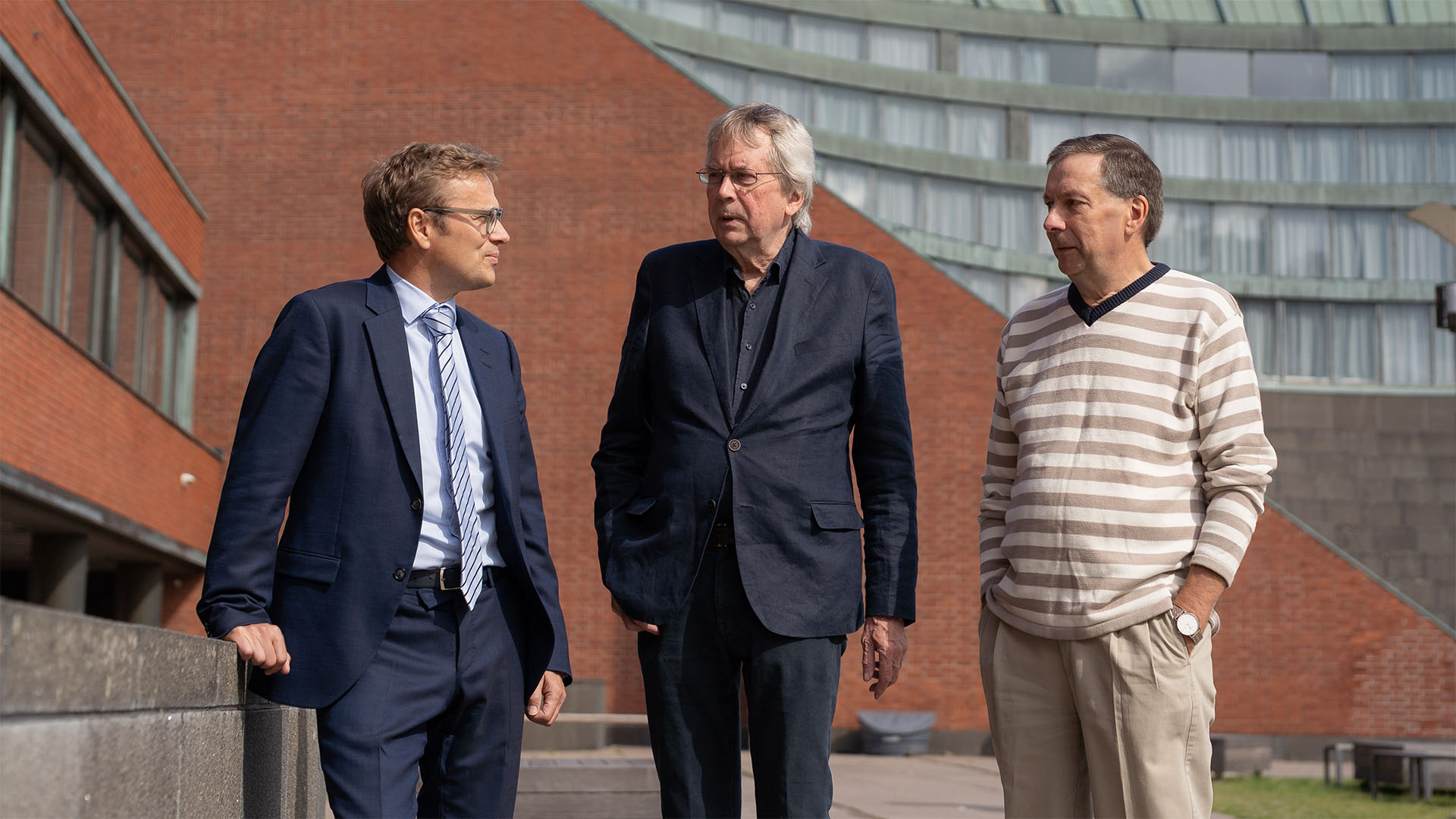40 years of computational fluid dynamics: FINFLO supports the Finnish Air Force and European Space Agency
The FINFLO software is designed to simulate flows around aircraft, space probes and ships. Originating in the 1990s, the software remains relevant today, enabling advanced compressible flow calculations and simulations of dynamically changing flow environments.
In the mid-1980s, two representatives from the Finnish Air Force arrived at what was then the Helsinki University of Technology to meet with Professor Seppo Laine, who was responsible for aerodynamics. They wanted to discuss how computational fluid dynamics could provide additional information about fighter aircraft performance in the future.
The Air Force wanted to learn how to predict the service life of fighter jets. This requires, among other things, calculating the aerodynamic forces on the aircraft.
Timo Siikonen, Senior Advisor, Elomatic
Thus, in 1987, a computational fluid dynamics research project was launched at Helsinki University of Technology, for which Siikonen and another researcher were hired.
However, it soon became clear that suitable commercial software was not available, so one had to be developed in-house. The researchers set to work, and later other researchers from the Aerodynamics Laboratory also participated in the project. One of them was Esa Salminen, who joined the team in the 1990s after working at the aerodynamics laboratory on other projects since 1985. Salminen still works with FINFLO simulations at Elomatic today.
A pioneering solver was born
The original goal was ambitious: to simulate an entire aircraft within three years.
“We didn’t quite make that deadline, but in 1994 we succeeded in simulating an entire aircraft,” Salminen recounts.
The result was the FINFLO solver, software for calculating flows, which was advanced from its inception and remains so over 30 years later. Development work on the solver continued until the early 2000s.
The solver simulates how aircraft, space landers, and ships behave under the influence of air, water, or gas. With the aid of developed additional tools, the results can also be analyzed and visualized. The solver successfully addressed the Air Force’s original request.
We created an understanding of how hornets should be flown to ensure they last as long as possible in service.
Timo Siikonen, Senior Advisor, Elomatic
From wind tunnels to precise simulation
In the past, air flows affecting large objects were most often studied in wind tunnels using scale models. As computers began to develop more rapidly in the 1970s, wind tunnel testing could be replaced by computation-based simulations. The computer programs used in the aerodynamics field at that time calculated air movement using fairly simplified models based on ideal flow potential theory and associated boundary layer analysis that accounted for friction.
A significantly more accurate way to model flows is to use the Navier-Stokes equations, which precisely describe the motion of gases and liquids. FINFLO is also based on these equations.
In addition to flows related to aircraft, FINFLO can calculate flows associated with ships, pumps, and compressors, and has even been used to calculate the cooling of nuclear power plant fuel rods, for example.
New capability to the team
When you know what kinds of loads are applied to, for example, some aircraft’s wings, stabilizers, or control surfaces, you can make the aircraft operate as efficiently as possible with optimal performance, says Patrik Rautaheimo, who joined the FINFLO team in 1993. Today, Rautaheimo serves as Chairman of the Board at Elomatic.
Having studied at Helsinki University of Technology, Rautaheimo ended up on the FINFLO team when he found a summer job at TKK’s Aerodynamics Laboratory – the same place where Siikonen and his team were developing the solver.
After a successful summer, Rautaheimo agreed with Siikonen to begin his master’s thesis on turbulence modeling, which is used in FINFLO. Over the decades, approximately one hundred master’s theses and twenty doctoral dissertations have been completed related to FINFLO.

FINFLO software developers at the former Helsinki University of Technology campus – at the birthplace of the software’s development. In the picture from left to right: Patrik Rautaheimo, Timo Siikonen, and Esa Salminen.
Parallel computing brought additional power
When Rautaheimo joined the FINFLO team, the solver’s basic flow computation code was already well developed, but the challenge was turbulence modeling.
Rautaheimo’s main task became determining how turbulence could be better modeled by utilizing parallel computing. Although the research was, in Rautaheimo’s words, sometimes painstaking, it nevertheless produced results. He also developed FINFLO’s code so that calculations could be performed significantly faster than before, using multiple or even hundreds of computer processing cores simultaneously.
“Esa and I were a good team. Esa is a guru at creating geometries and computational meshes, and I focused on flow computation. Timo led the entire project and was involved in reviewing, questioning, and challenging what we did,” Rautaheimo explains.
Analyzing Space Landers for the European Space Agency
FINFLO was developed at Helsinki University of Technology until 2001, when it was decided that it was time to establish a company around FINFLO. It was named Finflo Oy.
Since then, in addition to the Air Force, computational fluid dynamics analysis with FINFLO has been done for the European Space Agency and other clients.
Right now, we’re calculating the functionality of a Mars lander. We’re simulating its descent to the Martian surface and determining how the lander oscillates as it descends. This ensures that it lands in the correct orientation on the Martian surface.
Timo Siikonen, Senior Advisor, Elomatic

Elomatic has been involved in several Mars lander and space probe projects. A project for the European Space Agency is currently underway.
FINFLO has been used to analyze planetary landers before. In the 1990s, the client was the Finnish Meteorological Institute, which wanted to know what the aerodynamic conditions were during descent for an instrument aboard the Huygens probe that was landing on Saturn’s moon Titan. The descent system for the Finnish Meteorological Institute’s planned Mars MetNet spacecraft was also optimized using FINFLO in the 2010s.
Computational fluid dynamics expertise will be needed in the future too
In 2017, Elomatic acquired Finflo Oy. With the acquisition, ownership rights to the FINFLO code transferred to Elomatic, which became Finland’s leading provider of computational services.
“Through the acquisition, we became part of a larger group and could utilize our expertise even more effectively. Elomatic gained top-level computational expertise, which complements the consulting & engineering firm’s portfolio,” Rautaheimo says.
Although FINFLO’s development began nearly 40 years ago, the solver remains significant: it can calculate advanced compressible flows and simulate dynamically changing flow environments. It is also faster than its commercial competitors in many applications.
Siikonen, Salminen, and Rautaheimo all believe it is important that Finland maintains internationally high-level computational fluid dynamics expertise. This is also a matter of security of supply—especially in such an unstable geopolitical situation. The need for computational fluid dynamics is therefore not disappearing, Salminen says.
“With FINFLO, very complex flow-related phenomena can be studied on land, at sea, and in the air. We are research-minded problem solvers, and we gladly investigate what kind of value can be achieved through computational fluid dynamics.”
Simulation saves time and money
FINFLO computational fluid dynamics and simulation saves time and money when expensive test equipment doesn’t need to be built for testing and when simulation reveals, for example, how equipment should be designed and used.
When dealing with objects the size of aircraft or ocean-going ships, physically testing the flows associated with them is not always even possible, not to mention Mars landers. An aircraft or a 200-meter-long ship cannot be built for every test, nor is it possible to conduct tests in space conditions.
Sometimes scale models have been built for testing, but with them it is difficult or even impossible to depict the properties of, for example, a large ship or aircraft. Computational fluid dynamics, on the other hand, can create a test situation that perfectly corresponds to reality.
With computation, the effects of changes can be seen quickly, and the object, for example, an aircraft fuselage, can be optimized so that it withstands and functions as well as possible in all situations.
Contact us

Would you like to know more?
Fluid Dynamics
With our Computational Fluid Dynamics (CFD) services, you can analyze the fluid dynamics and heat or mass transfer of fluids and thereby develop your products. You also save time and money.
FINFLO®
FINFLO® is a Navier-Stokes flow solver capable of handling incompressible and compressible flows. The development of FINFLO dates back to 1987, when a research project in CFD was started at the Helsinki University of Technology (HUT). This research led to the development of a sophisticated flow solver.
